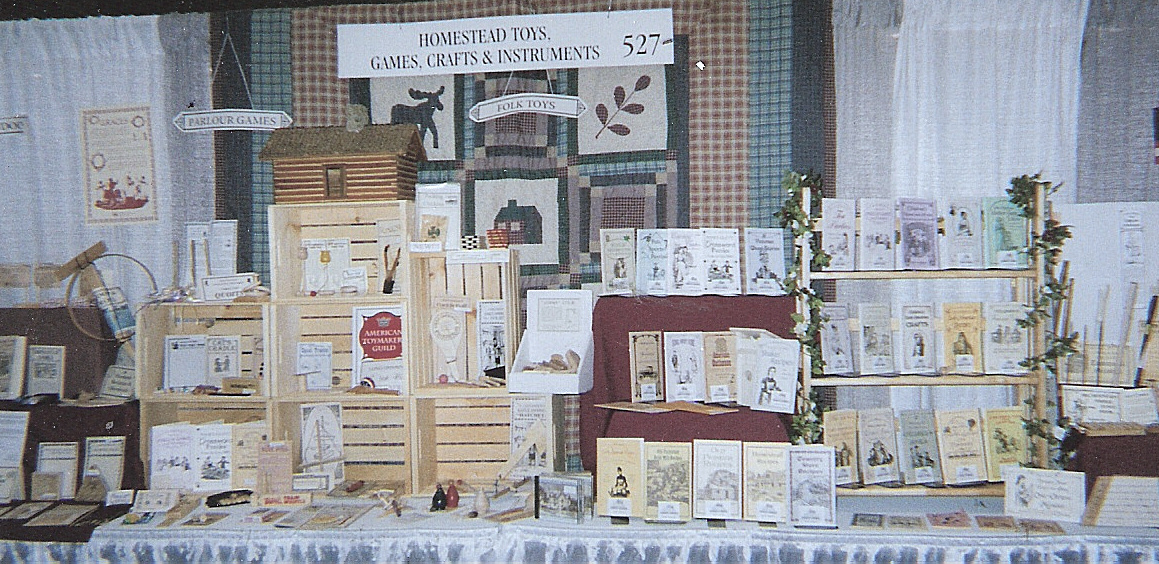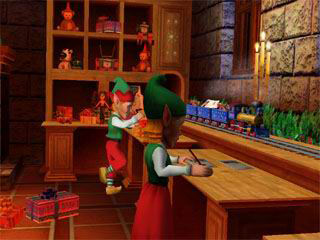 |
Once upon a time, we , the busy bees at Homestead Folk Toys,
were originally known as "Toy Elves". That was in our early
days, when we formed our business around the Swiss-Alps
cottage industry concept of toy-making and were known for
our special Christmas-package grouping of toys.
Through the following years, we began to focus more and more
on researching and developing authentic American folk toys,
and thus was born Homestead Folk Toys, Games and Crafts.
These days, we simply call ourselves researchers, craftsmen
and women, web designers, publishers, fabric specalists,
woodworkers and, in general, jacks of many trades.
We exhibit our product line both regionally and nationally
at professionally-recognized trade shows , such as the ones
pictured here, including the Museum Store Association's
expositions which are held in major market areas
both regionally and all across the United States.
Exhibiting at these shows gives us our greatest
opportunity to talk to the museum buyers in person
and get very important feedback on our product
line.
In the past, we have also demonstrated many of
our more popular folk toys at invitation-only fairs
and even in school classrooms.
One of the greatest joys in our business life is to
see historical folk toys being used by today's children.
Here, we see two children enjoying the game of Graces
on a rainy day, inside the classroom. We have always
believed that kids of all ages (including adults) should
have the opportunity to experience these delightful
pastimes.
One of our joys here at Homestead Folk Instruments is
crafting inexpensive harps and other musical instruments for beginning musicians all across the country. These instruments
are entirely of our own design, and are, therefore, exclusive
to us.
We invite you to check back from time to time as we add
add to our online scrapbook.
A much milder pastime popular with young ladies was the Game of Graces,
which traces its origins to 1830. Designed to make girls more graceful, the game involved
two players, each with two wooden dowels. The players--using rods--tossed a 9-inch
diameter hoop back and forth, while presumably making an effort not to look like a klutz.
After catching the hoop, a player let it slide down her rods, crossing them in an X shape,
before tossing the hoop back to her companion. The first player to catch the
hoop 10 times won. By the late 20th century, the Game of Graces had dwindled,
though an outfit in Nashville, Ind., called Homestead Toys still sells a set of
hoops and rods for those who want to give the game a try.
A repository of dead hobbies, Homestead also sells a kit to play Quoits,
a horseshoe-like tabletop game that involves a wooden peg and rings.
Quoits dates back to ancient Greece and Rome, and there are mentions of
the game in Britain from the 14th century onward.
Pronounced K-waits, this game is the forerunner to horseshoes. Its origins stretch back to the ancient Greeks and Romans. There is evidence of quoits being played in England as long ago as 1833. It spread to America, where quoits clubs formed. Still played in some parts of the British Isles and the U.S
Fivestones, another traditional game, is an early American wooden folk version of jacks.
 |
 |
 |

Scrap Book
A Homestead site. Site designed and hosted by Homestead Folk Toys.
Product images and designs Homestead Folk Toys and their respective owners. All rights reserved.
 | ||||
 |
 | ||||

Made in USA
American History Pioneer Folk Toys, Games, Crafts, and Music from Homestead Folk Toys in the Historical Village of Nashville, Indiana




Return Home
Return to Top

©
Site Map



See story on our Toys in Forbes Magazine
In Pictures: Hobbies Long Gone
 | ||||
 | ||||
 | ||||



